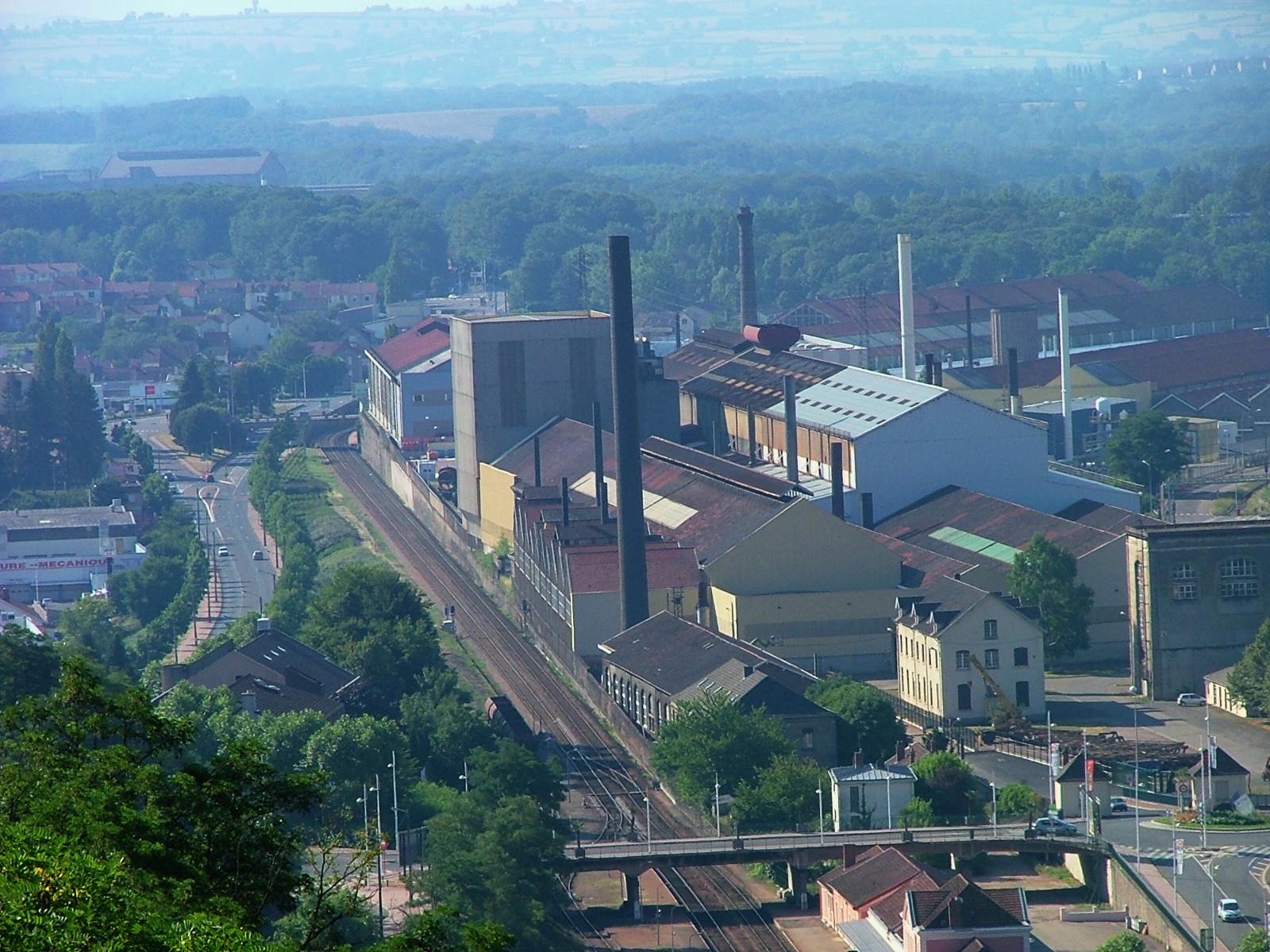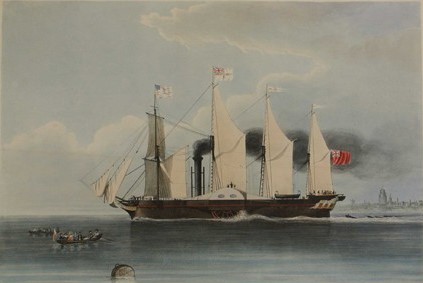|
François Bourdon
François Prudent Bourdon (29 July 1797 – 19 April 1865) was a French engineer and inventor, mainly interested in development of steam-powered boats for inland navigation. He is known for designing one of the first steam hammers. Early years François Prudent Bourdon was born at Seurre in the Côte-d'Or department of France on 29 July 1797. He was educated in the College of Mâcon. His father owned mills and river boats in Mâcon, and François joined his business after leaving school. After several year, François Bourdon and his younger brother founded a workshop. At Saint-Laurent-sur-Saône, a town opposite Mâcon, Francois and his brother Auguste ran an establishment whose main purpose was steam-powered wheat milling. In 1824 Bourdon took out a patent for a new tugboat design. In 1824 at Lyon, on the Saône between la Mulatière and the île Barbe, Bourdon made several attempts at steam-powered towing. He ran into various difficulties, mostly not technical. Bourdon's firs ... [...More Info...] [...Related Items...] OR: [Wikipedia] [Google] [Baidu] |
Seurre
Seurre () is a Communes of France, commune in the Côte-d'Or Departments of France, department in eastern France. This commune lies at the crossroad of routes to Dijon, Chalon-sur-Saône, Dole, Jura, Dole, Beaune, and Louhans. Population See also *Communes of the Côte-d'Or department References External links Non official site of Seurre Communes of Côte-d'Or Burgundy {{Beaune-geo-stub ... [...More Info...] [...Related Items...] OR: [Wikipedia] [Google] [Baidu] |
Eugène Schneider
Joseph Eugène Schneider (29 March 1805 – 27 November 1875) was a French industrialist and politician. In 1836, he co-founded the Schneider company with his brother, Adolphe Schneider. For many years he was a Deputy, and he was briefly Minister of Commerce and Agriculture in 1851. Early life Eugène Schneider was born on 29 March 1805 in Bidestroff, in the department of Moselle, France. He was the brother of Adolphe Schneider (1802–45), who served as a Deputy from 1842 to 1845. His father died when he was young, and he took a modest job in a trading house in Reims, then in the bank of Baron François-Alexandre Seillière. Business career Schneider showed great aptitude for business, and at the age of 25 was appointed a director of the forges at Bazeilles. In 1833, his brother was appointed managing director of Le Creuzot, and he was added as co-manager the same year. He made a powerful contribution to the prosperity of this establishment. After his brother die ... [...More Info...] [...Related Items...] OR: [Wikipedia] [Google] [Baidu] |
Marseille
Marseille (; ; see #Name, below) is a city in southern France, the Prefectures in France, prefecture of the Departments of France, department of Bouches-du-Rhône and of the Provence-Alpes-Côte d'Azur Regions of France, region. Situated in the Provence region, it is located on the coast of the Mediterranean Sea, near the mouth of the Rhône river. Marseille is the List of communes in France with over 20,000 inhabitants, second-most populous city proper in France, after Paris, with 873,076 inhabitants in 2021. Marseille with its suburbs and exurbs create the Aix-Marseille-Provence Metropolis, with a population of 1,911,311 at the 2021 census. Founded by Greek settlers from Phocaea, Marseille is the oldest city in France, as well as one of Europe's List of oldest continuously inhabited cities, oldest continuously inhabited settlements. It was known to the ancient Greeks as ''Massalia'' and to ancient Romans, Romans as ''Massilia''. Marseille has been a trading port since ancient ... [...More Info...] [...Related Items...] OR: [Wikipedia] [Google] [Baidu] |
Société Nouvelle Des Forges Et Chantiers De La Méditerranée
The ''Société Nouvelle des Forges et Chantiers de la Méditerranée'' (FCM) was a French shipbuilding company. The ''Société des Forges et Chantiers de la Méditerranée'' was founded in 1853 by Philip Taylor (civil engineer), Philip Taylor and subsequently incorporated in 1856 in the newly established joint stock company ''Société Nouvelle des Forges et Chantiers de la Méditerranée'' founded by Armand Béhic. It eventually had shipyards in La Seyne-sur-Mer, near Toulon, and in Graville, now part of Le Havre. After going into insolvency in 1966, the company was absorbed into the ''Constructions industrielles de la Méditerranée''. The company also produced tanks before World War II, most notably Char 2C, FCM 2C and FCM 36. Some ships built * (1865) — first ironclad to circumnavigate the Earth * HNLMS Schorpioen (1868) An ironclad that is now a museum ship * Ottoman ironclad Asar-i Tevfik, ''Asar-i Tevfik'' (1868) — an ironclad warship of the Ottoman Navy built in the ... [...More Info...] [...Related Items...] OR: [Wikipedia] [Google] [Baidu] |
Louis-Eugène Cavaignac
Louis-Eugène Cavaignac (; 15 October 1802 – 28 October 1857) was a French general and politician who served as head of the executive power of France between June and December 1848, during the French Second Republic. Born in Paris to a prominent family, Cavaignac was educated for a military career. Shortly after returning from service in the Morea expedition he took part in the July Revolution, and in 1832 was sent to Algeria, at the start of the French invasion, where he served with distinction for the next 16 years. He started his political career following the French Revolution of 1848 and the establishment of the Second Republic, being elected member of the National Assembly, and soon became one of the leaders of the Moderate Republicans. As Minister of War in the French provisional government, Cavaignac was tasked with putting down the June Days uprising, a revolt by Parisian workers against the National Assembly, and for this was temporarily given emergency powe ... [...More Info...] [...Related Items...] OR: [Wikipedia] [Google] [Baidu] |
French Revolution Of 1848
The French Revolution of 1848 (), also known as the February Revolution (), was a period of civil unrest in France, in February 1848, that led to the collapse of the July Monarchy and the foundation of the French Second Republic. It sparked the wave of revolutions of 1848. The revolution took place in Paris, and was preceded by the French government's crackdown on the campagne des banquets. Starting on 22 February as a large-scale protest against the government of François Guizot, it later developed into a violent uprising against the monarchy. After intense urban fighting, large crowds managed to take control of the capital, leading to the abdication of King Louis Philippe on 24 February and the subsequent proclamation of the Second Republic. Background Under the Charter of 1814, Louis XVIII ruled France as the head of a constitutional monarchy. Upon Louis XVIII's death, his brother, the Count of Artois, ascended to the throne in 1824, as Charles X. Supported by the u ... [...More Info...] [...Related Items...] OR: [Wikipedia] [Google] [Baidu] |
Claude Verpilleux
Jean-Claude Verpilleux (2 May 1798 – 13 October 1875) was a French mine laborer who became a leading engineer, manufacturer and inventor. He was involved in the design of early railway locomotives, and invented innovative steam-powered "grapple boats" driven by traction wheels running along the bed of the river or canal. Early years Claude Verpilleux was born at Rive de Gier in 1798, son of a canal worker. His father died when he was ten. His limited education allowed him to read, calculate, and to write with some difficulty. On 15 August 1810 he began work at a daily salary of one franc at the Montjoint mines in Rive de Gier. One of the mine concessionaires, Fleurdelix, was struck by Verpilleux's activity and intelligence, and had him help install a British steam engine, which was not working satisfactorily. Verpilleux immediately understood how the machine worked, and in 1814 at the age of 16 was placed in charge of it. He examined it carefully and improved it, then built a ... [...More Info...] [...Related Items...] OR: [Wikipedia] [Google] [Baidu] |
Exposition Academie F Bourdon Le Creusot
{{disambig ...
Exposition (also the French for exhibition) may refer to: *Universal exposition or World's Fair *Expository writing *Exposition (narrative), background information in a story *Exposition (music) *Trade fair * ''Exposition'' (album), the debut album by the band Wax on Radio *Expository preaching See also *Expo (other) *Expose (other) *Expos The Montreal Expos () were a Canadian professional baseball team based in Montreal. The Expos were the first Major League Baseball (MLB) franchise located outside the United States. They played in the National League (baseball), National League ... [...More Info...] [...Related Items...] OR: [Wikipedia] [Google] [Baidu] |
James Nasmyth
James Hall Nasmyth (sometimes spelled Naesmyth, Nasmith, or Nesmyth) (19 August 1808 – 7 May 1890) was a Scottish engineer, philosopher, artist and inventor famous for his development of the steam hammer. He was the co-founder of Nasmyth, Gaskell and Company manufacturers of machine tools. He retired at the age of 48, and moved to Penshurst, Kent where he developed his hobbies of astronomy and photography. Early life Nasmyth was born at 47 York Place, Edinburgh where his father Alexander Nasmyth was a landscape and portrait painter. One of Alexander's hobbies was mechanics and he employed nearly all his spare time in his workshop where he encouraged his youngest son to work with him in all sorts of materials. James was sent to the Royal High School (Edinburgh), Royal High School where he had as a friend, Jimmy Patterson, the son of a local iron founder. Being already interested in mechanics he spent much of his time at the foundry and there he gradually learned to work ... [...More Info...] [...Related Items...] OR: [Wikipedia] [Google] [Baidu] |
SS Great Western
SS ''Great Western'' was a wooden-hulled paddle-wheel steamship with four masts, the first steamship purpose-built for crossing the Atlantic, and the initial unit of the Great Western Steamship Company. Completed in 1838, she was the largest passenger ship in the world from 1837 to 1839, the year the went into service. Designed by British civil engineer Isambard Kingdom Brunel, ''Great Western'' proved satisfactory in service and was the model for all successful wooden Atlantic paddle-steamers. She was capable of making record Blue Riband voyages as late as 1843. ''Great Western'' worked to New York for eight years until her owners went out of business. She was sold to the Royal Mail Steam Packet Company and was scrapped in 1856 after serving as a troopship during the Crimean War. Development and design In 1836, Isambard Kingdom Brunel, his friend Thomas Guppy and a group of Bristol investors formed the Great Western Steamship Company to build a line of steamships for th ... [...More Info...] [...Related Items...] OR: [Wikipedia] [Google] [Baidu] |
SS Sirius (1837)
SS ''Sirius'' was a wooden- hulled sidewheel steamship built in 1836 by Robert Menzies & Sons of Leith, Scotland for the London-Cork route operated by the Saint George Steam Packet Company. The next year, she opened transatlantic steam passenger service when she was chartered for two voyages by the British and American Steam Navigation Company. By arriving in New York a day ahead of the ''Great Western'', she is usually listed as the first holder of the Blue Riband, although the term was not used until decades later. Description ''Sirius'' was long from stem to stern and a depth of hold of . She had a beam of and a draught of . The ship had a capacity of 412 tons burthen and a gross register tonnage of 703 tons.Sheppard, pp. 86, 91 The ship had a two-cylinder steam engine built by Wingate & Co. driving two paddlewheels. Her boilers provided steam to the engine at a working pressure of about . The engine produced a total of and the ship had a maximum speed of . Th ... [...More Info...] [...Related Items...] OR: [Wikipedia] [Google] [Baidu] |







